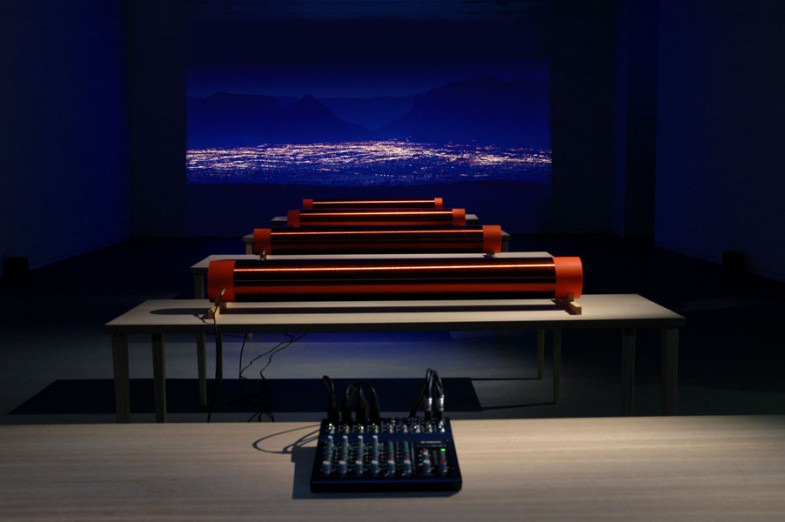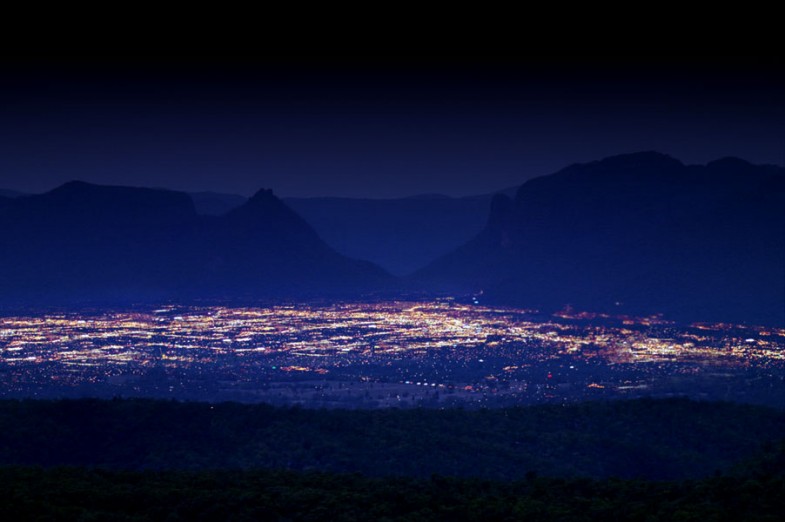2006 – Perth Institute of Contemporary Art, Perth Western Australia, 2007 – The Visitors – Aliens and UFOs in Contemporary Art, Penrith regional Gallery & Lewers Bequest, Penrith, Australia, 2008 – Turn and Widen, TWWR, The 5th Seoul International Media Art Biennale, Seoul, Korea. Breaking News From the Ether, La Panacee Montpellier 2014 Orup Desert & OE antennae: HD video installation with live sound from of 4 custome built VLF antenna.
Artists Statement from the catalogue: download pdf TwoWorks_catalogue
We never intended to follow in Reich’s footsteps literally, but we did want to dedicate our work to him. Wilhelm Reich was a great twentieth-century explorer of the inner depths of the psyche and the invisible in nature.
Reich’s view of the world was unique, even dangerous, given the political climate of the time. The US government saw his radical politics and inventions with technology, such as the “Cloud Buster” and “Orgone Boxes”, as a threat, which sadly led to his imprisonment and death; he was a refugee from fascism, dying in exile in an American Federal Prison. Our works are concerned with energy observation, sensation and atmosphere. The work allows for differential relationships between the fictional and the phenomenal to be established between the elements in the space.
The live electromagnetic atmosphere that audibly resonates in the room, comes about through the vibration of the 4 kilometres of wire that makes up the OE (Orgone Energy) antennae.< “Reich’s gift is to make us think again about the apparent givens of natural forces, energy fields and how the world is assembled.
Reich continually challenged the order of things with a kind of limitless approach to discovery that was truly interdisciplinary. His cosmos allowed for the possibility and ‘proof’ of extraterrestrial life, a holistic understanding of the drive and motivation for sexual energy – including the effect of climatology – and an original take on astrophysics, along with an ethics that upended the moral order of human social relationships. ” Work like ours may not have been possible without an encounter with a figure such as Reich. Contact with Reich occurred early on for one of us, and was picked up on by the other over many years of conversation. Over the years Reich has inspired us – indirectly – with a multitude of ideas and an attitude or approach to living that equals the influence of any of those great artists [i] understood as shifting the ground in their wake, who have, in a sense help to write the future of art-making and indeed the futurity of the world.
In the same way, Reich’s work always hovers in the background as a kind of zig- zag inspirational springboard, representative of an exemplary life, in which experiments take place on their own terms – autonomously – thinking at the forefront.
Even though we name this work as Two Works for Wilhelm Reich, it might be better to think of it as a whole – the one work. This is the way we have come to collaborate where each person has the freedom to work within a broader assemblage of parts or to paraphrase Henry Miller – ” individual yet related. These works emerge out of the kinds of experiments that we like to conduct: recordings of the VLF (Very Low Frequency) electromagnetic scape, which is the earth’s natural radio or via the construction of an image from a composite of places not far from our home that hopefully shatters a more predictable sense of place. We live only kilometres away from a place where a phantom city is said to appear in the vast and mysterious Burragorang valley at night, an event that has been seen by many a local over the years. If this is also a kind of delirium, at least it’s the product of something deeper and trickier than what is generally served up on television – the blue eucalyptus vapour of the mountains as cinema screen – swept up in a village tale and transmitted like a rumour.
We like the kind of smooth images—part hallucination, part escape—that are apparitions, a “station break” in the consensual hallucination that passes for reality provided by the media.
Finegan writes,” In Haines’ cinema of immanence, there’s no unconscious to be dredged. No narrative, no signifiers. There are no stories to be told, rather shifts of intensities pertaining to states…. There’s a Deleuzian geology in which the relation is not even of one thing-to-thing, but rather one of surfaces or planes, and speeds and differential flows.
It may be that the subconscious is all surface anyway. A factory of weightless images – the mind-belching images as pure cinema. “Not a just image – just images” to quote Goddard.
Hinterding’s sculptural explorations into the energetic nature of materials and forms have produced resonant systems and structures that provide evidence of energy through sound. These sounds, which are not normally audible, are threshold sounds, sounds in extension – vibrations in need of translation – seemingly close but actually far away, as they travel within the magnetic field lines enfolding the earth. Reich’s discovery of Orgone revealed an energy that appeared to be a creative force in nature, neither a form of electromagnetism nor of matter, but fundamental to both.
Hinterding has produced a body of work exploring the unseen and, therefore, occulted world of electro-magnetic phenomena. Previously, her approach has been ‘scientific’, working with coils and currents, producing electrical storms and lightning inside the gallery (‘Electrical Storms’, ‘Koronatron’, for instance). As such, she’s often played the role of magus, disrupting the order of things just a little, displacing and corrupting natural events to allow the unseen to manifest.
In our reflection on Reich as a figure in our own artistic lives and dreams, we see in him a legacy of a kind of all too rare, radicalised opening up. Wilhelm Reich could strike a flash through a field or discipline like a bolt of lightning, but, however brief it was at the time, it must have stopped everyone in their tracks.
David Haines & Joyce Hinterding, 2006
Endnotes:
Artists carry a storehouse of artists and their influences within them. In different fields, artists such as Artaud, Duchamp and Cage for instance, have dramatically shifted the ways in which their respective disciplines are understood, however, the impact of great thinkers and innovators from other disciplines, such as Reich or Freud, is rarely acknowledged.
Finegan, Anne (2002) The Seventeenth Century of Occultation & Surface
Finegan, Ann (2000) The Levitation Grounds

